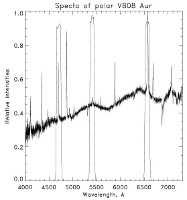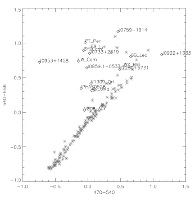About Survey
The main purpose of the survey is searching for polar candidates. Polars are
magnetic close binary systems on the late stages of evolution consisting of
a magnetic white dwarf (B>10 MG) and an M-K red dwarf.
Today, about 150 polars are known.
We plan to increase the number of known polars by a
quarter in two years. The increase in the number of polars will help to
build robust distributions of orbital periods for polars and compare them
with non-magnetic systems, as well as to study the effects of the magnetic
field on the evolution of close binary systems. To better understanding, we
also made a summary table
about known polars.
(
https://wwwmpa.mpa-garching.mpg.de/RKcat/).
Methods and Tools
One of the spectral features of polars is a strong emission line of HeII
4686. It's intensity comparable with the emission of Balmer series lines. We
selected three medium-band filters with middle wavelengths 470, 540,
656 nm and bandwidth 10 nm
(https://www.edmundoptics.com).
These filters cover HeII 4686, Halpha lines and continuum area between them
(Fig. 1).
Serial observations in three bands allow to plot colour-colour
diagrams and distinguish polar candidates from other objects
(Fig. 2).
The method was realised on
SAO RAS
Zeiss-1000 telescope with a new Multi-Mode Photometer-Polarimeter (MMPP).
with a new Multi-Mode Photometer-Polarimeter (MMPP).
There is a pipeline for fast reduction of observations using
IDL
and Python.

